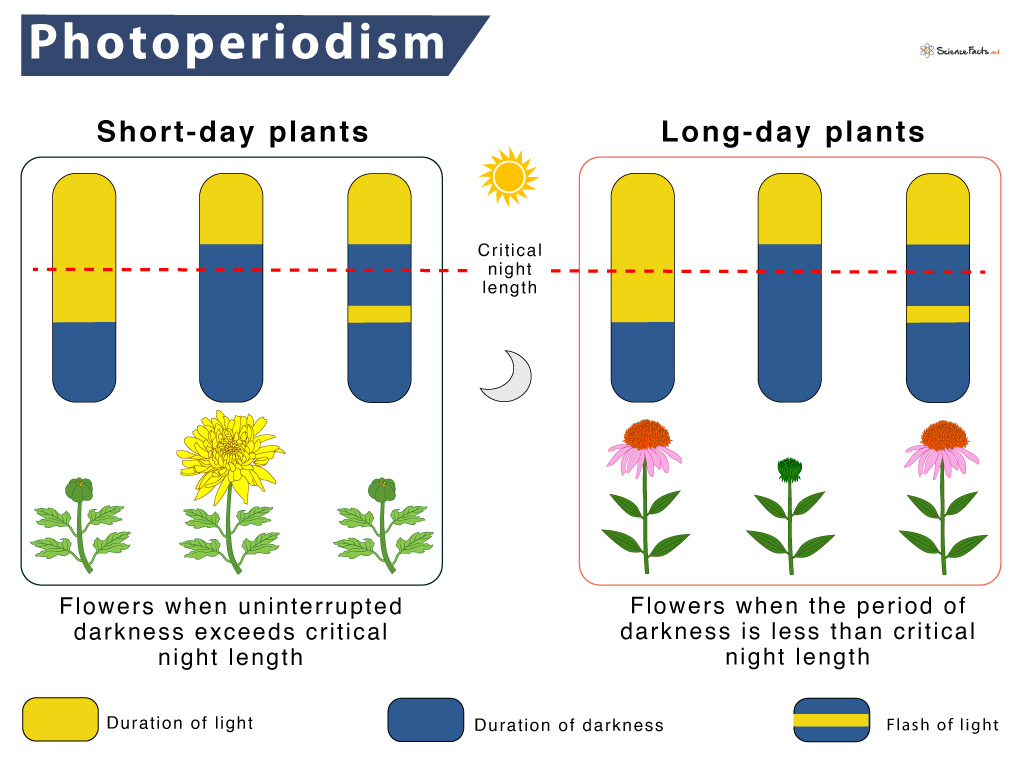Photoperiodism
What is Photoperiodism?
Photoperiodism is a phenomenon that occurs in living organisms like plants and animals. It is defined as the developmental response to the length of day and night. The relative period of day and night is called photoperiod. While photoperiodism is a common occurrence in plants, animals are also found to respond to light, although differently.
Plants flower and produce fruits only during a particular season and a specific time of the year. On the other hand, some plants grow only at higher altitudes. Every plant needs a particular duration of light to flower and form fruits that vary from one season to another. While they get a more extended period of sunlight during the summer season, the length of daylight decreases significantly during winter.
The phenomenon of photoperiodism was first discovered by W.W. Garner and H.A. Allard while performing experiments with the Biloxi variety of soybeans and Maryland mammoth variety of tobacco.
Photoperiodism in Plants
Plants can sense changes in the length of day and night and hence, flower at the right time. This sense is achieved by the use of a light-sensitive protein called phytochrome. This protein also has a role in sensing seasonal changes.
How Photoperiodism Affect Plant Growth
Every plant needs a certain amount of light to perform its essential functions such as food production, flowering, and fruiting. Without these crucial functions, plants will not be able to grow and reproduce. The length of exposure to light required by a plant to flower is called the critical duration, which varies from one species to another. On the contrary, recently scientists have discovered that the length of darkness is also equally crucial for the plant to flower.
Classification of Plants
Based on photoperiod and critical duration, all plants can be classified mainly into five groups. These groups are described below.
1. Long-Day Plants (LDP)
These plants require a longer duration of light to flower. Their critical duration is 14-16 hours. In other words, the night length should be less than the number of daylight hours they need. Therefore, the time of the photoperiod is very vital. An increase in the photoperiod, or even a brief exposure to light during the dark period, boosts flowering in LDP plants. They are also known as short-night plants. LDP plants flower during late spring or early summer since the photoperiod’s length is maximum during that period. Also, they are usually found only in places where the period of daylight is long.
Examples: Spinach, radish, and sugar beet
There are some long-day plants that require exposure to shorter photoperiods earlier in the flowering season. A few examples are winter rye, candytuft, and certain varieties of wheat.
2. Short-Day Plants (SDP)
These plants are opposite to LDP plants and require shorter photoperiods to flower. SDP plants require a critical duration of about 8-10 hours and a continuous period of darkness of approximately 14-16 hours for flowering. In SDP plants, flowering is prevented if the dark period is interrupted in any way, no matter how briefly. SDP plants are usually found in places where the length of the day is too short. Recently, it has been found that getting an uninterrupted period of darkness is more crucial for an SDP plant to flower than getting the 8-hour daylight.
A short-day plant will not flower if the dark period is interrupted with a brief exposure of red light of wavelength 640-680 nm. However, this inhibitory effect is reversed with subsequent exposure to far-red light of wavelength (730-740 nm).
Examples: Sunflower, rice, and soybeans
There are some short-day plants that require exposure to a more extended photoperiod earlier in the flowering season. These are called long short-day plants. A few examples are Goethe plant or air plant and night jasmine.
3. Day-Neutral Plants (DNP)
These plants’ flowering is not affected by the length of the photoperiod or darkness. In other words, they are neutral to the period of day and night.
Examples: Roses, tomato, and pea plant
Photoperiodism in Animals
Like plants, animals also respond to the length of the photoperiod though in an entirely different manner. Several biological and behavioral changes in animals, such as the migration of the seasonal birds, the singing frequency of the canary bird, or the sexual reproductive behavior, all depend on the length of the photoperiod that changes with every season.
Importance of Photoperiodism
Photoperiodism makes a significant contribution to the growth and life cycle of plants and animals. Most plants reproduce through seeds that are found inside the flowers. Those flowering plants must flower to perpetuate. Also, individual animals breed only during a particular season that directly depends on the photoperiod’s length. Taking all these into account, here is the importance of photoperiodism.
- Determines the season when the plant forms flowers and fruits.
- Helps to keep plants, such as radish and carrot, in the state of vegetative growth and thus increase the plant yield. It also helps to support others, such as pea plants, in their reproductive stage.
- Helps in cross-breeding of plants where the behavior of two or more plant varieties are mixed to prepare a better or high-yielding variety. This new variety has higher productivity, are resistant to pests, and are more attractive for pollinators.
- Responsible for inducing early flowering in plants by exposing them to prolonged cold temperatures by a process known as vernalization.
- Helps the plant to flower throughout the year in greenhouses
FAQs
Ans. Phototropism is the growth or movement of plants or any organism in response to light. In contrast, photoperiodism is the developmental response of plants or any organism to the relative length of day and night.
Ans. Photoperiodism is the developmental response of plants or any organism to the relative length of day and night. In contrast, vernalization is the process of inducing flowering in plants by exposing them to prolonged cold temperatures.
-
References
Article was last reviewed on Friday, February 3, 2023




